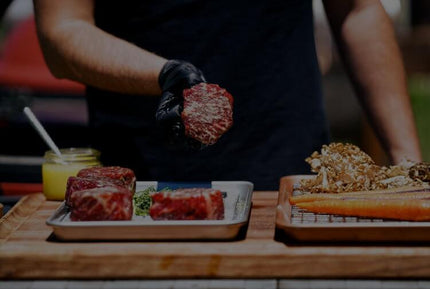

FROM RANCH TO TABLE
SRF BLOG
30-Minute Beef and Veggie Stir-Fry
By: Snake River Farms
Quick Sheet Pan Fajitas
By: Snake River Farms
One-Pot Chili con Carne
By: Snake River Farms
Mini Philly Cheesesteak Pizzas
By: Snake River Farms
Weeknight Char Siu Smoked Pork Steaks
By: Snake River Farms
Vietnamese Lemongrass Pork Chop Noodle Salad (Bún Chá)
By: Snake River Farms
Tuffy Stone's Ribs
By: Snake River Farms
Sweet Sausage with Roasted Vegetables and Couscous
By: Snake River Farms
Sweet and Sour Pork Meatballs
By: Snake River Farms
Spicy Sausage Pasta with Mushrooms and Wild Rocket
By: Snake River Farms
Spicy Harissa Pork Chops with Tzatziki
By: Snake River Farms
Smoked Pork Ribs with Apple & Apricot BBQ Glaze
By: Snake River Farms
Smoked Pork Collar Tacos
By: Snake River Farms
Smoked Hot Sausage Links with Tomato and Red Pepper Jam
By: Snake River Farms
Slow Cooker Carnitas
By: Snake River Farms
Slow Cooker BBQ Pork Short Ribs with Green Apple and Toasted Pecan Slaw
By: Snake River Farms
Slab Bacon Benedict
By: Snake River Farms
Sheet Pan Smoked Pulled Pork Nachos
By: Annella Kelso
Sausage with Roasted Fennel and White Corn Polenta
By: Mandy Tanner
Sausage Stuffed Apples with Fried Sage
By: Snake River Farms
Sage and Thyme Rack of Pork with Squash, Onions and Balsamic-Apple Syrup
By: Snake River Farms
Recipes
Sage and Thyme Rack of Pork with Squash, Onions and Balsamic-Apple Syrup
By: Marge Perry & David Bonom
Rosemary Pork Chop with Chimichurri, Roasted Baby Potatoes and Asparagus
By: Snake River Farms
Roasted Kurobuta Pork Loin with Fig and Orange Mostarda
By: Snake River Farms

























